m6A methylation reader IGF2BP2 activates endothelial cells to promote angiogenesis and metastasis of lung adenocarcinoma
- PMID: 37353784
- PMCID: PMC10288689
- DOI: 10.1186/s12943-023-01791-1
m6A methylation reader IGF2BP2 activates endothelial cells to promote angiogenesis and metastasis of lung adenocarcinoma
Abstract
Background: Lung adenocarcinoma (LUAD) is a common type of lung cancer with a high risk of metastasis, but the exact molecular mechanisms of metastasis are not yet understood.
Methods: This study acquired single-cell transcriptomics profiling of 11 distal normal lung tissues, 11 primary LUAD tissues, and 4 metastatic LUAD tissues from the GSE131907 dataset. The lung multicellular ecosystems were characterized at a single-cell resolution, and the potential mechanisms underlying angiogenesis and metastasis of LUAD were explored.
Results: We constructed a global single-cell landscape of 93,610 cells from primary and metastatic LUAD and found that IGF2BP2 was specifically expressed both in a LUAD cell subpopulation (termed as LUAD_IGF2BP2), and an endothelial cell subpopulation (termed as En_IGF2BP2). The LUAD_IGF2BP2 subpopulation progressively formed and dominated the ecology of metastatic LUAD during metastatic evolution. IGF2BP2 was preferentially secreted by exosomes in the LUAD_IGF2BP2 subpopulation, which was absorbed by the En_IGF2BP2 subpopulation in the tumor microenvironment. Subsequently, IGF2BP2 improved the RNA stability of FLT4 through m6A modification, thereby activating the PI3K-Akt signaling pathway, and eventually promoting angiogenesis and metastasis. Analysis of clinical data showed that IGF2BP2 was linked with poor overall survival and relapse-free survival for LUAD patients.
Conclusions: Overall, these findings provide a novel insight into the multicellular ecosystems of primary and metastatic LUAD, and demonstrate that a specific LUAD_IGF2BP2 subpopulation is a key orchestrator promoting angiogenesis and metastasis, with implications for the gene regulatory mechanisms of LUAD metastatic evolution, representing themselves as potential antiangiogenic targets.
Keywords: Angiogenesis; Exosomes; IGF2BP2; Lung adenocarcinoma; Metastasis; N6-methyladenosine; Single-cell RNA sequencing.
© 2023. The Author(s).
Conflict of interest statement
The authors declare no competing interests.
Figures

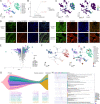
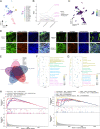
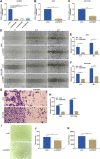
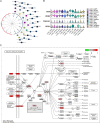
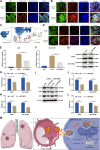

Similar articles
-
IGF2BP2 promotes lung adenocarcinoma progression by regulating LOX1 and tumor-associated neutrophils.Immunol Res. 2024 Dec 17;73(1):16. doi: 10.1007/s12026-024-09563-9. Immunol Res. 2024. PMID: 39688738
-
WT1-AS/IGF2BP2 Axis Is a Potential Diagnostic and Prognostic Biomarker for Lung Adenocarcinoma According to ceRNA Network Comprehensive Analysis Combined with Experiments.Cells. 2021 Dec 23;11(1):25. doi: 10.3390/cells11010025. Cells. 2021. PMID: 35011587 Free PMC article.
-
LPCAT1 promotes brain metastasis of lung adenocarcinoma by up-regulating PI3K/AKT/MYC pathway.J Exp Clin Cancer Res. 2019 Feb 21;38(1):95. doi: 10.1186/s13046-019-1092-4. J Exp Clin Cancer Res. 2019. PMID: 30791942 Free PMC article.
-
IGF2BP2: an m6A reader that affects cellular function and disease progression.Cell Mol Biol Lett. 2025 Apr 9;30(1):43. doi: 10.1186/s11658-025-00723-9. Cell Mol Biol Lett. 2025. PMID: 40205577 Free PMC article. Review.
-
[Progress in Single-cell RNA Sequencing of Lung Adenocarcinoma].Zhongguo Fei Ai Za Zhi. 2021 Jun 20;24(6):434-440. doi: 10.3779/j.issn.1009-3419.2021.102.19. Epub 2021 May 24. Zhongguo Fei Ai Za Zhi. 2021. PMID: 34024063 Free PMC article. Review. Chinese.
Cited by
-
Progression of m6A in the tumor microenvironment: hypoxia, immune and metabolic reprogramming.Cell Death Discov. 2024 Jul 20;10(1):331. doi: 10.1038/s41420-024-02092-2. Cell Death Discov. 2024. PMID: 39033180 Free PMC article. Review.
-
IGF2BP2 promotes lung adenocarcinoma progression by regulating LOX1 and tumor-associated neutrophils.Immunol Res. 2024 Dec 17;73(1):16. doi: 10.1007/s12026-024-09563-9. Immunol Res. 2024. PMID: 39688738
-
SLC34A2 inhibits tumorigenesis and progression via upregulating LRRK2/TTF-1/SELENBP1 axis in lung adenocarcinoma.Cancer Gene Ther. 2025 Aug;32(8):870-883. doi: 10.1038/s41417-025-00928-2. Epub 2025 Jul 2. Cancer Gene Ther. 2025. PMID: 40603644 Free PMC article.
-
RNA m6A modification in ferroptosis: implications for advancing tumor immunotherapy.Mol Cancer. 2024 Sep 28;23(1):213. doi: 10.1186/s12943-024-02132-6. Mol Cancer. 2024. PMID: 39342168 Free PMC article. Review.
-
Role of m6A modification in regulating the PI3K/AKT signaling pathway in cancer.J Transl Med. 2023 Nov 1;21(1):774. doi: 10.1186/s12967-023-04651-0. J Transl Med. 2023. PMID: 37915034 Free PMC article. Review.
References
Publication types
MeSH terms
Substances
LinkOut - more resources
Full Text Sources
Medical
Research Materials
Miscellaneous

